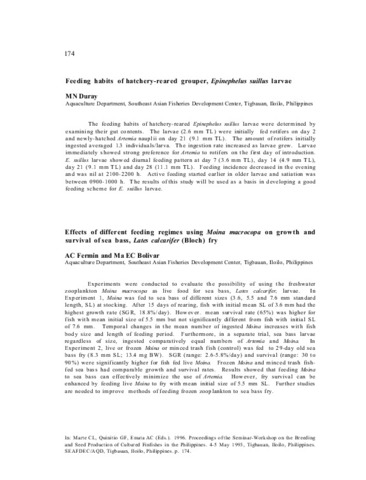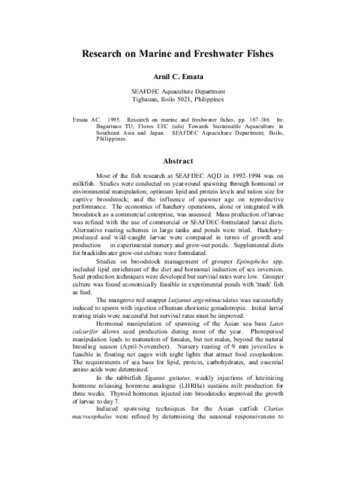Feeding habits of hatchery-reared grouper, Epinephelus suillus larvae
- Global styles
- MLA
- Vancouver
- Elsevier - Harvard
- APA
- Help
Share
抄録
The feeding habits of hatchery-reared Epinephelus suillus larvae were determined by examining their gut contents. The larvae (2.6 mm TL) were initially fed rotifers on day 2 and newly-hatched Artemia nauplii on day 21 (9.1 mm TL). The amount of rotifers initially ingested averaged 1.3 individuals/larva. The ingestion rate increased as larvae grew. Larvae immediately showed strong preference for Artemia to rotifers on the first day of introduction. E. suillus larvae showed diurnal feeding pattern at day 7 (3.6 mm TL), day 14 (4.9 mm TL), day 21 (9.1 mm TL) and day 28 (11.1 mm TL). Feeding incidence decreased in the evening and was nil at 2100-2200 h. Active feeding started earlier in older larvae and satiation was between 0900-1000 h. The results of this study will be used as a basis in developing a good feeding scheme for E. suillus larvae.
Suggested Citation
Duray, M. N. (1996). Feeding habits of hatchery-reared grouper, Epinephelus suillus larvae. In C. L. Marte, G. F. Quinitio, & A. C. Emata (Eds.), Proceedings of the Seminar-Workshop on Breeding and Seed Production of Cultured Finfishes in the Philippines, Tigbauan, Iloilo, Philippines, 4-5 May 1993 (p. 174). Tigbauan, Iloilo, Philippines: Aquaculture Department, Southeast Asian Fisheries Development Center.
Type
Conference paperISBN
9718511326
Related items
Showing items related by title, author, creator and subject.
-
Research on marine and freshwater fishes
Emata, Arnil C. (Aquaculture Department, Southeast Asian Fisheries Development Center, 1995)Most of the fish research at SEAFDEC AQD in 1992-1994 was on milkfish. Studies were conducted on year-round spawning through hormonal or environmental manipulation; optimum lipid and protein levels and ration size for ... -
Management of feeding aquaculture species
Alava, Veronica R. (Aquaculture Department, Southeast Asian Fisheries Development Center, 2002)This chapter teaches the reader to: differentiate the different feeding strategies in pond culture; learn feeding management methods such as stock sampling and record keeping, calculating daily feed ration, choosing ... -
Use of plant protein sources in aquafeed for high value marine species in ASEAN member states
Catacutan, Mae R. (Aquaculture Department, Southeast Asian Fisheries Development Center, 2015)Cultured marine aquatic species are predominantly carnivorous. Major species in the region are seabass, grouper, snapper, tiger shrimp, mangrove crab and abalone. These species, except for abalone, require a high level of ...







